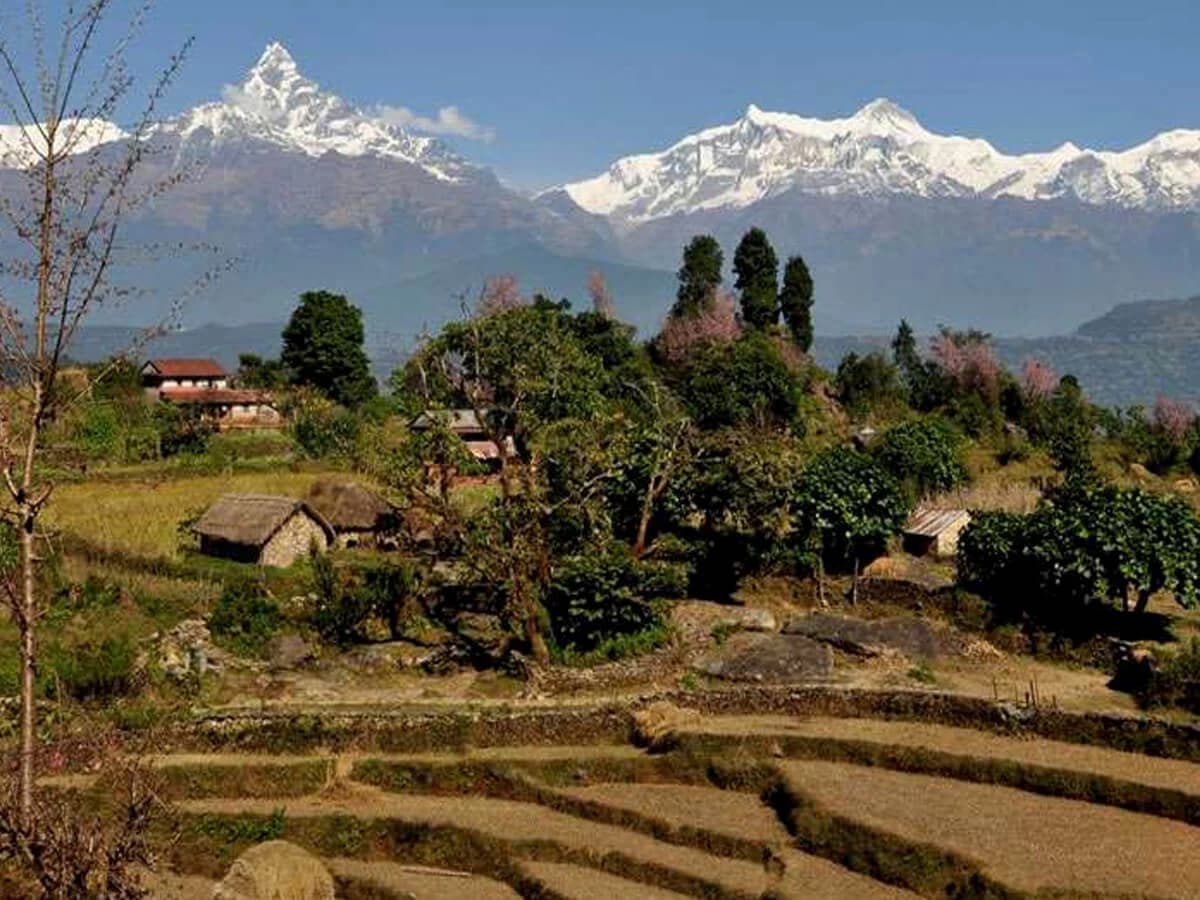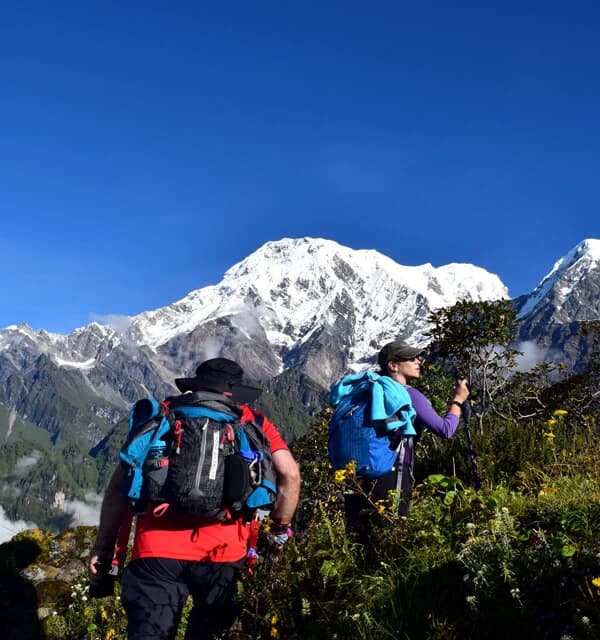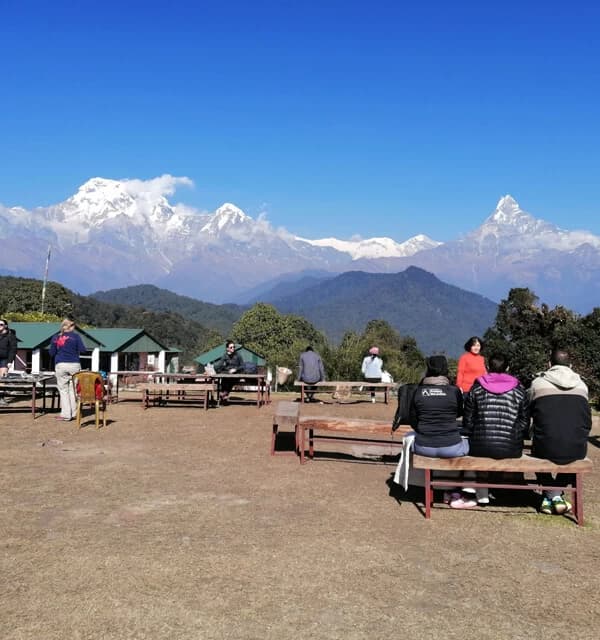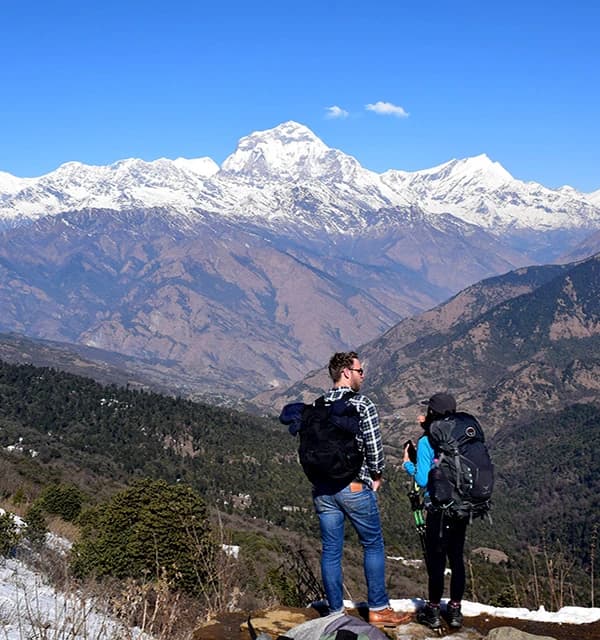The Panchase Trek offers stunning Himalayan views, diverse flora, and cultural immersion in rural Nepal, with a rewarding sunrise from Panchase Peak.
Panchase Trek - 3 Days
Panchase Trek Overview
Panchase Trek is one of the short treks around Pokhara away from the actual Annapurna trail but it is a rural-cultural off-the-beaten trek that offers an ideal way to discover natural beauty around Pokhara for those visitors on visit, without missing out on the incredible views over the Annapurna Himalayan Range and experiencing the village life. Our short trek starts in style with a gentle boat trip across Lake Phewa to take you to the start point, where a short climb will be rewarded with stunning views out across the Annapurnas, Machhapuchhare (Fishtail), Dhaulagiri, and Manaslu, which will form the backdrop to much of the trek. The trail will take you up to the World Peace Pagoda, through the forest where you can see the flora and fauna of Nepal, and past several villages where you can experience the daily lives of the local people. It takes you up to an elevation of 2500m on the summit of Panchase Hill, from which (if you are willing to get up early enough!) you can see a dramatic sunrise over the Himalayan giants.
Panchase is one of the closest short treks near Pokhara. Panchase is a point of five tall hills where they meet on the top. On the top of Panchase, there is a temple of Sidda Baba, Dharmasala, Mahadev temple, a view tower, and Buddha statues. The intersection of Kaski, Parbat, and Syangja districts is called Panchase. Panchase Hill offers impressive views of Dhaulagiri, Annapurna, Machhapuchhre, Lamjung Himal, and Manaslu, and some stunning views of sunrise and sunset. There is a Pancsila Lake and Barah temple at the top. It is said that saints used to stay there because when a fire caught in 1966, they moved elsewhere. However, it is a sacred site for yoga and meditation.
People and locals.
Panchase and its surrounding area are home to some 70,000 people, including Kalabang, Chitre, and Bhadaure. Deurali, Talibarang, Arthare, and Sidhane villages. Most of these villages have homestay facilities with welcoming hospitality. One needs to inform in advance if you are going to stay in one of those, and you have to be there before sunset.
Nature and wildlife
Panchase, resting on the lap of the Himalayas, is a complete package with its pristine beauty and topographical diversity to go with the blend of historic, religious, and cultural hues. Panchase, which abuts Kaski, Syangja, and Parbat districts, is a place of biodiversity and is home to endangered bird species of the world. In case you have not noticed. Panchase has biological diversity, as there are different kinds of birds, animals, butterflies, flowers, and vegetation. Harpan Khola—the origin of the famous Phewa Lake; Adhikhola, Ratikhola, Jarekhola, and Seti Khola—all these small rivers and rivulets flow from Panchase. The world-famous rhododendrons, Sunkhari and Leksallo, among other flowers, are the staple products of the area. Panchase is also known as the depot of endangered herbs and herbal medicine. The world's endangered herbs, such as Satuwa, Chattre Unyu, and Loth Salla, have existed since the time of dinosaurs. It is also home to animals like leopards, bears, deer, and many species of birds.
How are the accommodations and food in Panchase?
The accommodation on this route is quite basic compared to other popular trekking trails such as Ghorepani Poon Hill or the Annapurna Circuit in Annapurna. Local people run homestay services at Kalabang and Pumdi villages, offering stays in local homes. We saw one new lodge at Bhumdi that is a bit away from the village. For those who love experiencing local culture and don’t mind going through basic facilities, it is a firsthand opportunity to discover the locals and their lifestyle. The food is usually rice, potatoes, noodles, eggs, momo, chapati, etc., and tea or coffee for table drinks. Dal Bhaat (a Nepalese set meal that comes with boiled rice, lentil soup, fried/cooked vegetables, and pickles) is served in homestays. For beverages and bars, there are cold drinks, beer, distillery drinks, and Raksi (local wine).
When to go / what is the best time to trek?
Panchase Trek can be done year-round. The best advised time to trek there is fall (September –November); however, it can be one of the wet areas in the Annapurna region. There are high seasons that suit this trek, and the following months have traditionally been used as a guide for the favorite times of the year to do the Panchase trek.
Mid-September, November, and early December: this is Nepal's best time to go trekking; however, if the monsoon is late, then Panchase can remain cloud-covered until early October, rarely. Otherwise, the views at this time of year in Panchase are usually just gorgeous.
Mid-December to February: This is the winter season in Nepal; it has a clear sky, but it can be cold in Panchase, so warm clothing is advised. There is little chance of snowfall this time at Panchase.
March–April: this is the spring season, the end of the dry season, and the second-best time of the year for trekking. At this time there are rare chances of showers, rain, and storms in Pokhara; hence, Panchase is likely to have cloud cover sometimes.
May–June: This is Nepal's hot pre-monsoon period, and it can be quite warm. The valleys around Panchase flourish with flowers and new leaves, though, which makes for a very nice trek. However, cloud cover can be an issue.
June – Early September: Monsoon season and not a good time to go trekking to Panchase. The leeches in this area are so active when it is wet and the trail is slippery that downpours also increase greatly. For more details, please write to us about going trekking in Nepal at the best time. Nepal offers some of the best summer treks in Nepal's other areas.
How do I get there?
There are three options to start the hike. 1) Start the trek from Phewa Lake near Halanchowk via Kalabang and spend the first night in Bhumdi. 5-6 hours of walking bring you to Panchase Bhanjyang on the second day. There are half a dozen hotels at Bhanjyang, and it is 1.5 hours to Panchase Hill from there and just one hotel on the top. The next day, after enjoying the sunrise and hot breakfast, descending to the Chitre village of Parbat would be best via Pancsila Lake. 2) The second option is to start the hike from Peace Stupa and trek to Panchase via Pumdi Bhumdi. 3) The third option is to ride a local bus or take a taxi to Kande and then Bhadaure and trek to Panchase.
Distance and elevation
Panchase lies at a height ranging from 800 to 2,500 meters above sea level, which tells us of its diverse topography. The mountain ranges of Mt. Dhaulagiri, Mt. Annapurna, Mt. Manaslu, and Mt. Ganesh can be seen from Panchase, which is the source of Fewa Lake and rivers like Rati, Jare, Andhi, and Seti. The area lies at a distance of 28 kilometers from Pokhara, making it one of the attractive trekking destinations from the scenic city.
This trek is also a great extension to any of our tours of Kathmandu, Pokhara, and Chitwan Jungle Safari Tour.
How long is the Panchase Trek?
Normally, the Panchase Trek is 2 to 3 days long, though it can be extended up to 4 days via Australian Camp and Dhampus. Our preset 3-day itinerary is standard and starts at Pokhara at Phewa Lake. If you would like to customize it, please email us.
Other Major Features of Panchase Trek:
- Panchase is probably the best viewpoint of the Annapurna range near Pokhara.
- Suitable for all age groups as it is an easy walk in the lower Annapurna Foothills.
- Easy access from Pokhara, and there are 3 different routes to start the trek.
- Low package price compared to other trekking major routes in Annapurna
2-Days itinerary (cost: US$ 139/person based on a minimum of two people)
Day 1: Drive to Kande or Bhadaure, then trek to Panchase Bhanjyang
Day 2: Trek to Pokhara via Bhumdi and Peace Stupa and cross Phewa Lake. Transfer to hotel.
3-Days Itinerary
Day 1: Cross the lake Phewa trek to Bhumdi
Day 2: Trek to Panchase Hill
Day 3: Trek to Bhadaure and drive to Pokhara.
What to bring?
- Backpack (preferably 40/45 L as per your need)
- Proper hiking shoes, sandals/flip flops, 1/2 pair of socks, traveling towel
- Sleeping bag, warm clothes (if trekking in winter), headlamp,
- Hiking pants/shorts, 1/2 selected t-shirts, a windbreaker, and a sun hat/glasses.
- Rain gear, toiletries, and trekking poles.
- Basic medicines (e.g., paracetamol, ibuprofen, Bandages, Antifungal ointments, etc.)
For a more comprehensive packing list, click here, though you do not need all the listed items, as this is just a 3-day hike.
.webp&w=1200&q=75&dpl=dpl_CcHazofUWtxxcPG7rXgNGJzBcmvR)
.webp&w=1200&q=75&dpl=dpl_CcHazofUWtxxcPG7rXgNGJzBcmvR)

From Pokhara, take a boat to get to across the Phewa Lake then hike up to Peace Pagodaa 45 minutes after that we trek Bhumdi. A final climb of today takes you up to Bumdi village, home to Gurung and Brahman people, where you will spend the night and can learn more about these cultures. Accommodation, Camping and teahouse options available. Approx Walking Time: 4-5 hours.
After a short climb to really wake you up, the track continues through beautiful forest where you can see mountains regularly peeking out between the trees. Today is a great day for nature-lovers, as the path winds amongst diverse trees and plants and you can hear the birds above – you may even catch a glimpse of a monkey! Emerging from the trees briefly at Thulunchour you then continue under the cover of the forest until the path joins a dirt road, from which you can see panoramic views of the mountains. These include the Annapurnas, Lamjung, Gangapurna and Machhapuchhare (Fishtail) as well as three peaks over 8,000m: Dhaulagiri, Annapurna I and Manalsu, in the distance. Continuing along the jeep trail takes you gently uphill to Panchase Bhanjyang. Similar to last night’s stay, this village is home to Gurung and Brahman people. Accommodation: Camping and teahouse options available, Approx Walking Time: 4 hours, distance 10-11km.
This morning you climb the stone steps up to Panchase peak at almost 2,500m, the highest point of your trek. From here you will again be rewarded with stunning views over the mountains, and there is the option of getting up extra early to ascend to this point in time for sunrise! After catching your breath and taking in your surroundings, you descend down the far side of the hill to Alldanda. This afternoon consists of a gentle walk down to your campsite, with regular views of the mountains above and villages below. The campsite is situated just above the town of Bhadaure, where you can experience a mix of cultures as there are a range of residents including Gurung, Kami and Brahman. Drive to Pokhara from Nauda Danda.
This is our standard itinerary. It can be customized or slightly changed if required considering your pace and trekking habit that cause a change of day-to-day plan.

- One registered and experienced local trekking guide.
- 3 times meals (breakfast, lunch, and dinner) during the trek.
- Tea, coffee, cookies, and fresh fruits are served during the trek.
- Sharing twin/double bedrooms in teahouse lodges and homestays during the trek.
- Accommodation, food, salary, and equipment for your guide.
- Transfers by private car or van, depending on group size.
- Necessary insurance for your guide.
- Entrance fee if any required
- Taxes and paperwork charges.
- Accommodation, meals, and transportation in Kathmandu and Pokhara.
- All bar bills, beverages such as Coke, Fanta, Sprite, and mineral water.
- Travel insurance, Nepal Tourist Visa fees, items, and expenses of personal nature.
- Personal trekking equipment and rescue operations in case of emergency.
- Any expenses which arise due to a change of itinerary because of landslides, political trouble, strikes, etc.
- Laundry, phone calls, toiletries (toilet paper, soaps, shampoos, etc)
- Porter and horse or pony ride if needed.
- Tips for guide.
Check our dates published to see if it matches your time. We are happy to customize your tour perfectly to match your interests and needs, creating a unique travel experience just for you
My Hike to Australian Camp (starting from Kande, ending in Phedi) was a rewarding experience full of wonderful nature. Due to weather situation (wet, rainy and foggy due to Monsoon season) the sometimes very steep ascents and descents were very...
Last year I spent two weeks in Nepal including one week in Pokhara and around. Surely; I wanted to go trekking but not popular Annapurna trails as I do not like crowd. I did search for some of the less...





